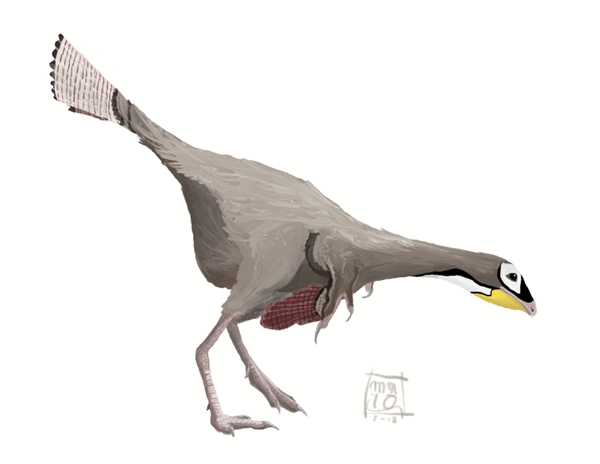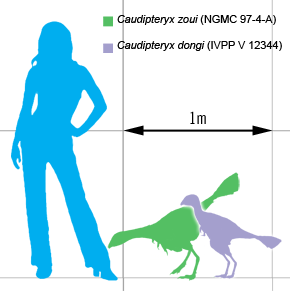home > natural history
Caudipteryx
zoui
"Zou's tail feather"

Originally published as an avialan close to Archaeopteryx, Caudipteryx is now thought to be a basal member of the oviraptorosaurian clade. This is the first known species, C. zoui, which was published alongside Protarchaeopteryx robusta in 1998 and was one of the second feathered dinosaurs to be described. C. zoui was the first named member of the caudipteridae, a family of early oviraptorosaurs which are generally so similar to each other it is difficult to tell them apart from skeletal characters alone. However, even among its contemporaries, C. zoui is a bit of an oddball. It has the smallest wings of any caudipterid, and seems to lack secondary feathers completey (only primary feathers, those anchored to the hand and wrist bones, are present). This arrangement is seen in young juveniles of the related Similicaudipteryx yixianensis, though the known C. zoui specimens were nearly fully grown and much larger than the juvenile stages of its relatives. The tiny wings, compared to the reduced, intenral and splint-like third finger (also found in the other species of Caudipteryx, but not in Similicaudipteryx), make this a truely terrestrial flightlss bird.
Most Caudipteryx zoui fossils (as well as the unnamed Cadipteryx species and the lone recognized fossil of Caudipteryx dongi andare found in lake sediments in a small area around the Chinese village of Zhangjiagou, suggesting that they had a limited range and/or specific habitat preferences. Some of these fossils are exquisitely preserved, even showing sclae impressions on the underside of the fingers (as well as flesh making them much fatter than the underlying bone). This is unusual given that some more advanced theropods had fingers (and sometimes toes) completely covered in feathers. Caudipteryx is often overlooked as the first Mesozoic dinosaur for which life coloration was reported. Its barred tail feather pattern (useful for display, forest camoflage, or both) was preserved in the holotype fossil and visible to th naked eye. The exact color of these feathers has not yet been determined.
.
.
.
.
.
Image Details:
Media: Digital, Adobe Photoshop CS3 with WACOM Graphire 3
License:
Creative Commons Attribution-Share Alike 3.0
You are free to Share (transmit, copy, and distribute) and to Remix (adapt or modify) the images on this page Under the following conditions: You must Attribute the work by giving written credit to Matt Martyniuk and linking to this Web site: http://www.azhdarcho.com (but not in any way that suggests that they endorse you or your use of the work).
For any reuse or distribution, you must make clear to others the license terms of this work. The best way to do this is with a link to this web page.Any of the above conditions can be waived if you get permission from the copyright holder. Nothing in this license impairs or restricts the author's moral rights.
DESCRIPTION
Length: 90cm (3ft)
Weight: 2kg (4.4lbs)
Location: Yixian Formation, Liaoning, China
Time: Aptian age, Early Cretaceous (125ma)
CLASSIFICATION
Kingdom: Animalia
Phylum: Chordata
Class: Stem-Aves
Order: Caenagnathiformes
Family: Caudipteridae
Genus: Caudipteryx
Species: C. zoui
SYSTEMATICS
Sauropsida
Diapsida
Archosauria
Ornithosuchia
Dinosauria
Theropoda
Coelurosauria
Maniraptora
Oviraptorosauria
Caudipteridae
